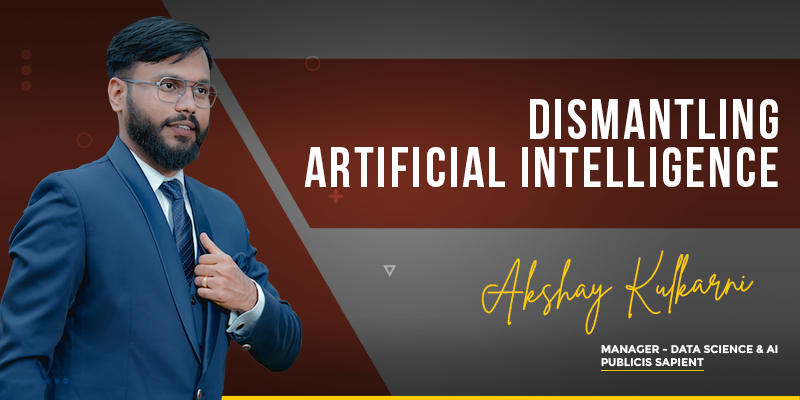Dismantling AI- Reconstructing Your Idea of AI

Artificial Intelligence is revolutionizing various industries in different ways. Today, businesses are gaining insights by analyzing the data to solve various issues. How can we leverage AI to solve some of the industry-related problems? You might be familiar with some of the AI applications that help in solving various business problems. Sentiment Analysis, Facebook Tag Suggestions, Fraud Detection, Spam Filter, Amazon Recommendations, Netflix Recommendations, Google Web Search Results, Customer Segmentation, Churn Prediction, and Self-Driving cars are few examples of such applications that solve business problems.
How to Define AI?
Artificial intelligence can be defined as the intelligence exhibited by machines or machines replicating human intelligence. How is machine learning and deep learning connected to AI? Machine Learning and Deep Learning are the small components or subsets of artificial intelligence. AI is more of an umbrella term that covers the components such as machine learning and deep learning. Any machines that exhibit intelligence possess artificial intelligence.
Similarly, machine learning is the science of teaching machines with the help of data to enhance machine intelligence. Machines use data as experience, which is similar to how human beings use the experience to learn various things. Machine learning can be defined as the building block of AI, whereas deep learning can be defined as the component of AI or a subset of machine learning.
Why AI is becoming popular?
AI is not a new technology; the concept of AI is familiar to us through science fictions and sci-fi movies. AI and machine learning have been here predominantly for the past 50 years. However, the deep learning era has started less than a decade ago.
If AI is known to the world for the past 50 years, then why are we making such hype around it?
The reasons for this sudden hype are:
- The amount of data has skyrocketed
- Data-driven decisions have become more profitable
- Massive increase in computation power
- Better accuracy even for unstructured data
As mentioned earlier, data and AI is becoming popular because companies or enterprises realized the value of data. Businesses have started storing data to extract business insights that can solve various business problems. Hence, there is a great demand for data engineers who can help organizations to store data that are readily accessible for data scientists/AI engineers. With time, the amount of data stored has been skyrocketed and companies started realizing that data-driven decisions are more profitable.
The massive increase in computing power with the emergence of Google Cloud Platform, Microsoft Azure, AWS, etc., that support in running machine learning and deep learning algorithms on a huge data. Later, NLP has been taken a lot of traction wherein 80% of data in the whole world is unstructured. Examples for unstructured data: Emails, videos, images, reviews, audio, etc.
Artificial Intelligence- A Brief History
The history of artificial intelligence is dated back to the time of Greek philosophers who had put their effort into developing a model for human thinking as symbols. In the 4th century BC, Syllogistic- the first formal deductive reasoning system was developed by Aristotle in his Prior Analytics.
In 1672, the first known calculator – The Staffalwalze that performed only four operations such as addition, subtraction, multiplication, and division. In 1936, Alan Turing – the founding father of modern AI introduced an automatic machine to the world. Alan Turing coined the term Turing Test in 1950 and the test attempts to identify that to which point a machine can imitate human intelligence.
At the beginning of the1950s, the practicing of AI has been started in colleges. In 1956, AI research was founded at Dartmouth College. The founders of AI research and students wrote programs that can win checkers, solve word problems in algebra, prove logical theorems, and speak English. They anticipated that they will develop pure AI within twenty years, but underestimated the difficulties involved in it and ultimately stopped funding on AI research.
In 1997, IBM’s Deep Blue defeated Gary Kasparov, the reigning World Chess Champion. In the year 2011, IBM Watson defeated Brad Rutter and Ken Jennings in the TV Quiz Jeopardy, which is considered as the first AI program to defeat people in non-math. In the year 2016, Google’s Deep Mind defeated the 18-time GO World Champion, Lee Sedol. With this achievement of Google’s Deep Mind, the world has reached way beyond the expectations in AI. Today, AI is booming in every industry.
Based on research studies, computing power will get cheaper by 2025. This shows that around that period the world can experience AGI, which is expected by 2030-2060.
Why does AI matter?
The best part of AI is that it is an open-source technology. AI is going to impact our lives, businesses and society at large in the coming years. Artificial Intelligence is broadly classified into three types:
- Artificial Narrow Intelligence (ANI)
Artificial Narrow Intelligence (ANI) is specialized in one area, which is referred to as narrow AI or weak AI. ANI is the only artificial intelligence that we have today that is designed to do single tasks such as driving a car, voice assistant, speech recognition, speech recognition, etc. This AI cannot replicate human intelligence as it only simulates human behavior using a narrow range of contexts and parameters.
- Artificial General Intelligence (AGI)
Artificial General Intelligence (AGI), also known as deep AI or strong AI is the concept of having general intelligence in machines that replicates human intelligence through learning and by applying the acquired intelligence to solve business problems.
- Artificial Super Intelligence (ASI)
Artificial Super Intelligence (ASI), which is a hypothetical intelligence that not only imitates human behavior or intelligence but also possesses self-awareness to exceed the ability and intelligence of human beings.
10 Business Applications of AI
Artificial intelligence is extensively used in various business applications across industries since data plays an important role in running businesses today. Data helps to drive business decisions across various sectors. AI business applications have gone beyond automated systems over the past years. These applications benefit businesses to become efficient in their operations and help to perform mundane tasks.
Here are the 10 different AI business applications used in various industries:
- Google Search Results
- Netflix Recommendations
- Healthcare Industry (To identify diseases)
- Virtual Assistants (Chatbots)
- Route Optimization (UBER)
- Google Autocorrect and Autocomplete
- Language Translation
- Grammar Checkers
- Market Prediction
- Autonomous Vehicles
10 Building Blocks of AI
Building blocks of AI are necessary for designing, developing and assembling AI-based systems. Here are the 10 building blocks of AI:
- Knowledge Engineering: Knowledge engineering is the field of AI, which transfers human knowledge into a database. The database will be used to imitate human reasoning and approaches to solve business problems.
- Robotics: It involves designing, developing, assembling, and use of robots to assist human beings.
- Speed Recognition: Speech recognition is used to enable AI applications to understand human commands or conversations to transcribe them into text.
- Natural Language Processing: Natural Language Processing (NLP) is the branch of AI in which computers are provided with the ability to understand speech and text just like human beings
- Natural Language Generation: Another subfield of AI that transforms data automatically into plain English text and enables machines to communicate back to human beings.
- Image Analysis: The ability of machines to extract significant information from images, especially digital images using image processing techniques.
- Machine Learning: A field of study that offers machines the ability to learn without being programmed. It is useful in developing computer programs that help to access data and learn through experience.
- Deep Learning: A subset of ML that uses algorithms to build artificial neural networks.
- Sensory Perception: It collects and interpret data about places, people and all types of objects to provide contextual information.
- Cognition: Cognitive applications can learn, act, interact, and evolve by themselves. Cognition when combined with other building blocks of AI can create pure AI.
AI/ML Lifecycle
What is AI/ML lifecycle? Machine learning/AI life cycle is the process that has to be followed by data science/AI projects. The ML/AI life cycle defines the step-by-step procedure that has to be followed by an organization to get business insights. The AI/ML lifecycle consists of project scoping, model designing, and development of ML/AI model, deployment of AI/ML model, testing/QA, monitoring, and maintaining.
Conclusion
According to Andrew NG, AI is the new electricity. Why has he compared AI to electricity? Decades ago, our ancestors were living without electricity. But today, the world cannot move forward without electricity because of heavy dependency on electricity. Similarly, artificial intelligence also is going to become universal and the world will get used to the benefits of AI just like electricity.




